Autologous Bone Marrow Derived Stem Cell (BM-MNC) Therapy for Pressure Injury in Spinal Cord Injury - A Pilot Study
Rajeshwar Nath Srivastava1*, Mukesh Kumar Dwivedi2, Amit Bhagat3, Ashok Agrahari3 and Lavini Raj4
1 Professor, Department of Orthopaedic Surgery, King George’s Medical University, India
2Research Associate, Department of Orthopaedic Surgery, King George’s Medical University, India
3 PhD Scholar, Department of Orthopaedic Surgery, King George’s Medical University, India
4Intern, Department of Orthopaedic Surgery, King George’s Medical University, India
Submission: July 19, 2018; Published: August 15, 2018
*Corresponding author: Rajeshwar Nath Srivastava, Professor, Department of Orthopaedic Surgery, King George’s Medical University, Lucknow, India.
How to cite this article: Rajeshwar N S, Mukesh K D, Amit B, Ashok A, Lavini R. Autologous Bone Marrow Derived Stem Cell (BM-MNC) Therapy for Pressure Injury in Spinal Cord Injury - A Pilot Study. J Head Neck Spine Surg. 2018; 3(3): 555612. DOI: 10.19080/JHNSS.2018.03.555612
Abstract
Ten Spinal cord injury (SCI) cases with grade 3 & 4 pressure injury (PI) were recruited. Five cases received autologous bone marrow derived mononuclear cells (BM-MNCs) therapy and five standard wound care. Significantly reduced surface area of PI in BM-MNC treated group was observed at week 6 (p=0.04) and at week 9 (p=0.001) as compared to standard wound care group. Similarly, significant reduction of depth was observed in BM-MNC group at week 9 (p<0.05) and exudate became significantly (p=0.001) lower from 3rd to 9th week. Clearance of slough and formation of red granulation tissue was significantly higher in BM-MNC group (p=0.001). The findings of this case series indicate that the use of autologous BM-MNCs could be a feasible option for the treatment of pressure injuries in SCI cases.
Keywords: Spinal cord injury; Pressure injury; Autologous bone marrow; Mononuclear cells
Abbrevations: PIs: Pressure Injuries; SCI: Spinal Cord Injury; MNCs: Mononuclear Cells; BM: Bone Marrow
Introduction
Pressure injuries (PIs) are a common yet challenging problem especially in people with Spinal cord injury (SCI) because of immobility and anaesthetic skin. They are difficult to treat with standard medical care and often recur [1-4]. Promising results have been reported in the treatment of small series of mainly chronic lower-extremity wounds with bone marrow-derived stem cells [5,6]. This case series was aimed to obtain the preliminary data on the use of autologous bone marrow derived mononuclear cells (BM-MNCs) to treat PIs in terms of clinical outcome and procedure safety.
Material and Methods
This study was conducted in the SCI unit, Department of Orthopaedic Surgery in collaboration with the Department of Transfusion Medicine, King George’s Medical University (KGMU), Lucknow, India. We enrolled individuals with SCIs aged 16 to 60 years with stage 3 to 4PIs. Grading of PI was done as per taxonomy of NPUAP [7]. Exclusion criteria were PIs with necrotic tissue that could not be removed on baseline debridement, osteomyelitis, exposed blood vessels and nerves in the wound, and specific comorbid conditions likely to impair wound healing such as diabetes mellitus, rheumatoid disease, and vasculitis.
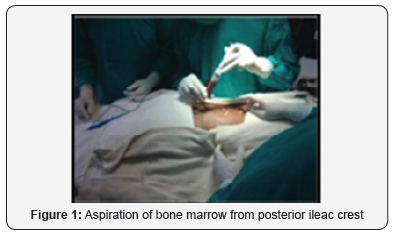
About 3 hours before cell therapy, autologous bone marrow (BM) (100ml) was obtained from the posterior iliac crest aspiration. Mononuclear cells (MNCs) were separated from bone marrow using plasma expresser. The BM-MNCs suspension was injected into the wound bed by 1ml syringe. For injection, the wound was subdivided with a grid into small areas of 1cm2. Infusion was performed into the wound bed as well as sub dermally at the borders of the wound. Wound dressings during the entire study period were performed with moist gauzes twice a day and followed up to 9 weeks (Figures 1-5).
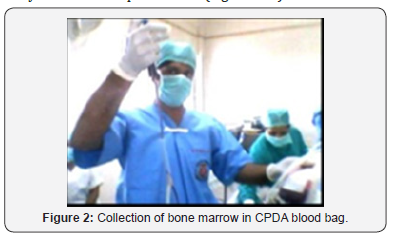
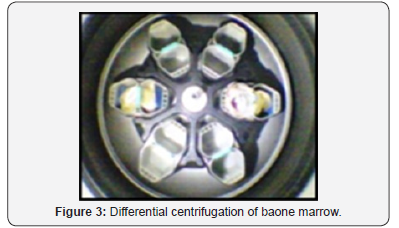

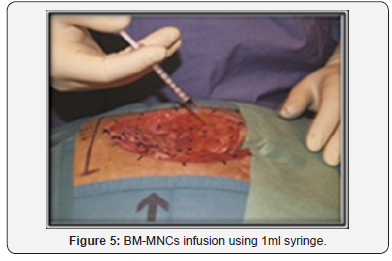
Results
Physical wound healing outcomes were compared at weeks 3, 6, and 9. Significantly reduced surface area of PI in BM-MNC group was observed at week 6 (p=0.04) which further reduced at week 9 (p=0.001) as compared to standard wound care group. Similarly, significant reduction of depth of PI was observed in BM-MNC group at week 9 (p<0.05). The exudate was similar (p>0.05) at the time of enrolment between both the groups and became significantly (p=0.001) lower in BM-MNC group from 3rd to 9th week. Clearance of slough and formation of red granulation tissue was significantly higher in BM-MNC group (p=0.001) (Table 1-3).

Values are presented as mean ± SD (Standard Deviation),
*: p<0.05 considered as statistically significant.
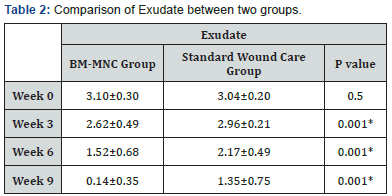
Values are represented as mean ± SD (Standard Deviation) 1Unpaired t-test, *Significant (p<0.05).
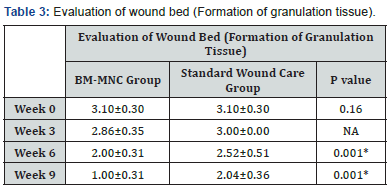
Values are represented as mean ± SD (Standard Deviation) 1Unpaired t-test, *Significant (p<0.05).
Physical wound healing outcomes were compared at weeks 3, 6, and 9. Significantly reduced surface area of PI in BM-MNC group was observed at week 6 (p=0.04) which further reduced at week 9 (p=0.001) as compared to standard wound care group. Similarly, significant reduction of depth of PI was observed in BM-MNC group at week 9 (p<0.05). The exudate was similar (p>0.05) at the time of enrolment between both the groups and became significantly (p=0.001) lower in BM-MNC group from 3rd to 9th week. Clearance of slough and formation of red granulation tissue was significantly higher in BM-MNC group (p=0.001) (Table 1-3).
Discussion
PIs are a common yet challenging problem in patients with SCI because they are difficult to treat with standard medical therapy. Promising results have been reported in the treatment of small series of mainly chronic lower-extremity wounds with bone marrow-derived stem cells [5]. The rationale behind the use of bone marrow derived cell therapy-is the fact that cells in chronic wounds are phenotypically altered or senescent or both. Therefore, they have a limited capacity to divide and are less responsive to stimulation by growth factors [6]. MNCs from a patient’s own bone marrow promote angiogenesis and this seems to be a key factor for optimal healing of skin wounds. Moreover, BM-MNCs secrete paracrine factors that could recruit macrophages and endothelial cells to enhance wound healing. The repair functions of BM-MNCs are thought to involve the secretion of factors such as VEGF or FGF, which could help prevent apoptosis, promote angiogenesis, assist in matrix reorganization [8,9]. The use of autologous BM-MNCs was designed to avoid problems of immunological rejection. The results observed in terms of PI healing were independent of the number of cells infused. The findings of this case series indicate that the use of autologous BM-MNCs could be a feasible option for the treatment of pressure injuries. The stem cell therapy proposed could avoid major surgical intervention, especially if these wounds have not responded to conservative and/or standard wound care.
Conclusion
The procedure of BM-MNC therapy was safe and well tolerated by the subjects. The efficacy can be better commented with larger sample size. But in this study, the results were highly satisfactory.
References
- Kuffler DP (2010) Techniques for wound healing with a focus on pressure ulcers elimination. Open Circ Vasc J 3: 72-84.
- Dwivedi MK, Srivastava RN, Bhagat AK, Agarwal R, Baghel K, et al. (2016) Pressure ulcer management in paraplegic patients with a novel negative pressure device: A randomised controlled trial. J Wound Care 25(4): 199-200.
- Srivastava RN, Dwivedi MK, Bhagat AK, Raj S, Agarwal R, et al. (2016) A non-randomized, controlled clinical trial of an innovative device for negative pressure wound therapy of pressure ulcers in traumatic paraplegia patients. Int Wound J 13(3): 343-348.
- Dwivedi MK, Bhagat AK, Srivastava RN, Jain A, Baghel K, et al. (2017) Expression of MMP-8 in Pressure Injuries in Spinal cord injury patients managed by negative pressure wound therapy or conventional wound care. J Wound Ostomy Continence Nurs 44(4): 343-349.
- Wettstein R, Savic M, Pierer G, Scheufler O, Haug M, (2014) Progenitor cell therapy for sacral pressure sore: a pilot study with a novel human chronic wound model. Stem Cell Res Ther 5(1): 18.
- Sarasúa JG, López SP, Viejo MA, Basterrechea MP, Rodríguez AF, et al. (2011) Treatment of pressure ulcers with autologous bone marrow nuclear cells in patients with spinal cord injury. J Spinal Cord Med 34(3): 301-307.
- National Pressure Ulcer Advisory Panel & European Pressure Ulcer Advisory Panel (2014) Prevention and treatment of pressure ulcers: Clinical Practice Guideline. NPUAP and EPUAP.
- Chen L, Tredget EE, Wu PY, Wu Y (2008) Paracrine factors of mesenchymal stem cells recruit macrophages and endothelial lineage cells and enhance wound healing. PLoS One 3(4): e1886.
- Kamata Y, Takahashi Y, Iwamoto M, Matsui K, Murakami Y, et al. (2007) Local implantation of autologous mononuclear cells from bone marrow and peripheral blood for treatment of ischaemic digits in patients with connective tissue diseases Rheumatology (Oxford)46(5): 882-884.






























